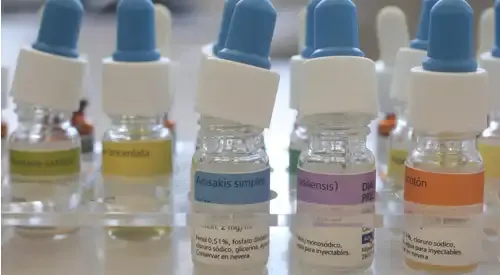Peanut Allergy
"At the Clinica we are conducting a clinical trial to assess the tolerability, safety and efficacy of an innovative treatment using an oral vaccine (immunotherapy) to treat peanut allergy".
DR. CARMEN D'AMELIO
SPECIALIST. ALLERGY AND IMMUNOLOGY DEPARTMENT

How do I know if I have a peanut allergy?
Peanut allergy is one of the most common food allergies today. It affects about 200,000 people in Spain and greatly affects the quality of life of the patient and his family members, since there are numerous foods that may contain peanut in their composition or be contaminated by this food.
The diagnosis of peanut allergy is based on the performance of simple routine tests in the Allergology office that include a skin test and in many cases a blood test to quantify the sensitization to the different peanut allergens and to be able to give the patient individualized recommendations in each case, about avoidance measures, treatment possibilities, assessment of the risk of reaction and indication on the treatment of possible reactions.

What are the symptoms of peanut allergy?
Peanut allergy comprises a wide variety of clinical symptoms that can range from mild discomfort after ingestion to severe allergic reactions.
Symptoms may occur after the first contact, appearing gradually with progressive worsening after repeated consumption of peanut-containing foods.
Symptoms may present as oral or pharyngeal itching, hives and itching of the skin, edema or swelling (face, eyes, lips...), respiratory symptoms (cough, shortness of breath...) and other generalized symptoms, leading to a reaction that may become severe if not treated early.
Most common symptoms of peanut allergy
- Itchy mouth and palate
- Hives and beans by the skin
- Rhinitis and/or conjunctivitis
- Breathing difficulty
- Edema or swelling of face, eyes, lips.
Do you have any of these symptoms?
Contact us to participate in the peanut allergy clinical trial
What are the causes of peanut allergy?
Peanuts are one of the most common allergens causing significant allergic reactions in children and adults. Most reactions to peanut are induced by IgE against the major peanut allergens Ara h 1, Ara h 2 and Ara h 3 or lipid transfer protein (LTP), which is a common allergen in Spain.
Food allergies can develop at any age, but children are much more likely to have a food allergy than adults. Although other food allergies can be outgrown with age, peanut allergy is less likely to resolve over time.
About 30% of people with peanut allergy are also allergic to other nuts.
How is peanut allergy diagnosed?

Diagnosis is made by means of a very simple skin test (prick test): a few drops of extract are applied to the skin of the forearm. It is also possible to perform a blood test to demonstrate and quantify the presence of specific IgE against peanut allergens and other foods.
In the Clinic's Allergology Laboratory it is also possible to detect the presence of specific IgE by means of a panel that includes 295 allergens (food and environmental allergens), which is especially useful in complex cases of patients with sensitization to multiple allergens, allowing individualized indications to be given to the patient in each case.
In some cases, where indicated, a provocation test will be performed, which consists of observing under medical control the reaction that occurs after ingestion of the food.
How is peanut allergy treated?
The first and most effective measure is to avoid contact with the food.
Peanuts can be present in many foods. Not only in an obvious way, but there are products that may contain "traces" of it. This can occur due to a process known as "cross-contamination". It occurs when other foods come into contact with peanuts and may induce a reaction in an allergic patient; such contamination may occur during food processing in a factory where peanuts are handled, or by the inadvertent presence of peanuts in a food that does not obviously contain peanuts.
We are currently conducting a clinical trial at the Pamplona and Madrid sites to test the tolerability, safety and dose-finding of an oral immunotherapy (vaccine) to treat peanut allergy. More information on this study can be obtained by e-mailing ensayocacahuete@unav.es
What clinical trials do we have on peanut allergy?
Vaccines for peanut allergy
Clinical trial to assess the efficacy and tolerability of a vaccine composed of nanoparticles containing peanut, taken orally, and intended to modify the patient's tolerance to peanut. This novel treatment consists of an oral immunotherapy against peanut with important advantages such as a short induction period, the convenience of self-administration at home and the oral route of administration.
Where do we treat it?
IN NAVARRE AND MADRID
Department of Allergology
of the Clínica Universidad de Navarra
The Department of Allergy and Immunology of the Clinic is part of the Global Allergy and Asthma European Network, composed of the 25 best departments of Allergy in Europe, chosen for their scientific excellence, multidisciplinary work, teaching and international activities.
We have the most advanced diagnostic techniques, we are at the forefront of research and we collaborate with the best experts. We have more than 50 years of experience in the field.
What diseases do we treat?

Why at the Clinica?
- More than 50 years of experience.
- Pioneers in the technique of molecular diagnosis by microarray.
- Nursing specialized in allergic diseases and their care.








